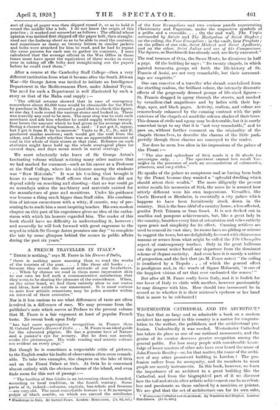"there is nothing more amusing than to read the works
of the tourists of the past. . . . I like those old books . . . because they reveal the mental attitude of our forefathers. . . When by chance we read in them some impression akin to our own we feel such a communicative satisfaction that they seem to be sharing the pleasure of the coincidence. When, on the other hand, we find them entirely alien to our tastes and ideas, how subtle is our amusement. It is most curious to note how artistic sensations may be poles asunder within an interval of three centuries."
Nor is it less curious to see what differences of taste are often involved in a difference of race. We may presume from the publisher's note which serves a-4 Preface to the present volume that M. Faure is a fair exponent at least of popular French
taste. No recent book upon Italy
" has had more appreciative recognition in France than M. Gabriel Faure's Heure,s d'Italie. . . . M. Faure is an ideal guide for the educated pilgrim. He has a genuine love of Nature and a painter's eye for scenery. But he does not merely evoke the picturesque. His wide reading and artistic culture are evident on every page."
But though he is sometimes a respectable critic of pictures, to the English reader his faults of observation often seem remark- able. To take two examples, the chapters on the lake of Orta and on the Pisani Palace at Strh. At Orta he is concerned almost entirely with the obvious charms of the island, and even
finds room for this sort of passage :—
" The basilica of San Giulio is an interesting church, founded, according to local tradition, in the fourth century. Some parts of it, indeed—columns, capitals, bee-reliefs and frescoes —are very old. The most remarkable feature is a Rcmanesque pulpit of black marble, on which are carved the attributes • Wancierims in Italtt. By Gabriel Faure. London : Heinemann. [15. 6d. net.1 of the four Evangelists and two curious panels representing Christianity and Paganism, under the respective symbols of a griffin and a crocodile. . . . On the end wall, The Virgin surrounded by Saints and The Martyrdom of Saint Stephen ; on the ceiling, the Four Evangelists; in the vault, four Prophets ; on the pillars of one side, Saint Michael and Saint Apollonia, and on the other, Saint Julius and one of his Companions. The figures, as Burckhardt has already said, are finely executed."
The real treasure of Orta, the Sa,cro-Monte, he dismisses in half a page. Of the building he says : "Its twenty chapels, in which painted terracotta groups set forth the life-history of St.
Francis of Assisi, are not very remarkable, but their surround- ings are exquisite."
One can conceive of a traveller who shrank scandalized from the startling realism, the brilliant colour, the intensely dramatic effects of the gorgeously dressed groups of life-sized figures— St. Francis dragged in agony through the streets, and mocked by vermilion-clad magnificoes and, by ladies with their lap- dogs, apes, and black pages. Activity, realism, and colour arc remorselessly enhanced by the cunning contrast with the pale exteriors of the chapels set amid the solemn shades of their trees. This drama of strife and agony may be detestable, but it is surely somewhat inept to say that it is "not very remarkable," and to pass on, without further comment on the originality of the chapels themselves, to describe the charms of the little park, prettily though these charms are conveyed to the reader.
Nor does he seem less alien in his impressions of the palace of the Pisani :—
" The size and splendour of Stra made it a fit abode for sovereigns only. . . . The spectator cannot but recall Ver. saiges in the presence of such an accumulation of colonnades, pilasters, and cat yatides."
He speaks of the palace as sumptuous and as having been built by the Pisani because they wanted a "splendid dwelling which should attest their wealth." The more diligently the present writer recalls his memories of Stra, the more he is assured how utterly different were his own impressions. Versailles, like Castle Howard or Blenheim, is essentially a city palace which happens to have been fortuitously stuck down in the country. Stra is the beau-ideal of a country house, a less affected, gentler Petit Trianon or Sans Souci. It is not decked out in marbles and pompous achievements, but, like a great lady in the country, banishes every hint of ostentation and relies entirely upon grace and simplicity for its effect. Cunning artifices are used to conceal its vast size; its rooms have no gilding or mirrors
to suggest the town, but are delightfully frescoed with chiaroscuro seasons or scenes from what might bo called the Fete Champitre
aspect of contemporary warfare. Only in the great ballroom can the present writer tecall any departure from the dominant scheme of elegant rusticity. And even here it is mostly a matter of proportion, and the fact that (as M. Faure notes) "the ceiling is irradiated by a Tiopolo . . . of which the general effect is prodigious and, in the words of Signor Molmenti, 'is one of the happiest visions of art that ever enchanted the senses.'" But after all M. Faure really loves Italy, and it is foolish for one lover of Italy to chide with another, however passionately
he may disagree with him. How should two innanwrati be in accord as to whether it is their mistress's eyebrow or her hand that is more to be celebrated !


































 Previous page
Previous page